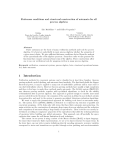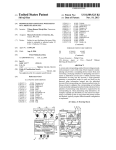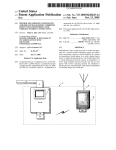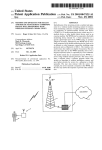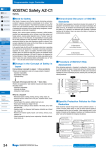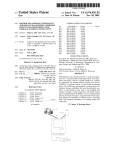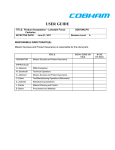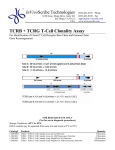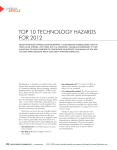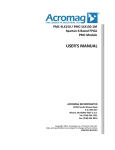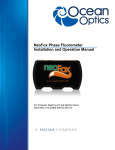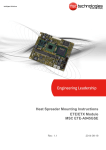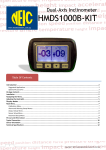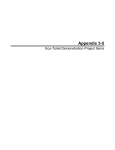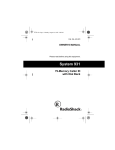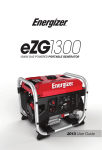Download Method and apparatus for health and disease management
Transcript
US 20040162466A1
(19) United States
(12) Patent Application Publication (10) Pub. N0.2 US 2004/0162466 A1
Quy
(43) Pub. Date:
Aug. 19, 2004
(54)
METHOD AND APPARATUS FOR HEALTH
AND DISEASE MANAGEMENT COMBINING
PATIENT DATA MONITORING WITH
WIRELESS INTERNET CONNECTIVITY
Publication Classi?cation
(51)
(52)
Int. Cl? .............................. .. A61B 5/00; F01N 3/10
US. Cl. ................... .. 600/300; 128/903; 340/539.12
(76) Inventor: Roger J. Quy, Mill Valley, CA (US)
Correspondence Address:
(57)
ABSTRACT
Mark D. Wieczorek
c/o Mayer Fortkort & Williams
Embodiments of the invention provide a method and appa
ratus for a Wireless health monitoring system for interac
tively monitoring a disease or health condition of a patient
by connecting an internet-enabled Wireless Web device
(“WWD”) to a digital camera or other health monitoring
device. The WWD may accommodate a memory device for
2nd Floor
251 North Avenue West
West?eld, NJ 07090 (US)
(21) Appl. No.:
10/773,501
(22) Filed:
Feb. 6, 2004
enhanced storage capabilities that may be particularly per
Related US. Application Data
tinent to data-intensive tasks such as the handling and
storage of images or other visual data. The health related
data is transmitted from the WWD to a server using standard
(63) Continuation-in-part of application No. 10/418,845,
internet protocols and may be integrated With various oper
ating systems for handheld or Wireless devices, especially
?led on Apr. 18, 2003, Which is a continuation of
application No. 09/738,270, ?led on Dec. 15, 2000,
those With enhanced capabilities for handing images and
noW Pat. No. 6,602,191.
visual data.
I
I
l
I
-------------.>
I
i
a
Computer 37
Patent Application Publication Aug. 19, 2004 Sheet 1 0f 12
US 2004/0162466 A1
a
O52N1mEb;!
GEF
Patent Application Publication Aug. 19, 2004 Sheet 2 0f 12
US 2004/0162466 A1
5:1
3359-30
6iN
Patent Application Publication Aug. 19, 2004 Sheet 3 0f 12
SERV
US 2004/0162466 A1
~$ERV
1a
FIG.3
/"
Y
E
APUCTION
5
Patent Application Publication Aug. 19, 2004 Sheet 4 0f 12
E.
29.05
US 2004/0162466 A1
N
H.
1mm
1mm
.91Q5[I
Patent Application Publication Aug. 19, 2004 Sheet 5 0f 12
..rL . m..5..15 2 .,"aurora-mu. E
u.2i0583.“:
{a92s
532.m
052m».
zoumn
zuiw 95.30 EH6 ¢u.5lomwi3nzom?uz
W3:50: m10EMF: "wig
...L.1.
8..
405M! 3NOSmWD
a
b
n6E
m
8.
.nu3>.<€m6
a.
28m OImkig 105w: mus n arr
US 2004/0162466 A1
awn: @E54. 9; 8'
D25)
a
4
352m3»
#5 6 3
953 5 m
3'
Patent Application Publication Aug. 19, 2004 Sheet 7 0f 12
US 2004/0162466 A1
HGT
Patent Application Publication Aug. 19, 2004 Sheet 8 0f 12
-
-
.TI.i
US 2004/0162466 A1
Patent Application Publication Aug. 19, 2004 Sheet 9 0f 12
US 2004/0162466 A1
FIG. 9
244
/
\
\
224
/Z46
Patent Application Publication Aug. 19, 2004 Sheet 10 0f 12
US 2004/0162466 A1
FIG. 10
HMD
260
Patent Application Publication Aug. 19, 2004 Sheet 11 0f 12
US 2004/0162466 A1
PATIENT
PRESENTS WITH
MALADY 202
FIG. 11
MEDICAL
PERSONNEL
ARRIVE ON SCENE
AND WWD IS
ENGAGED 204
V
PERSONNEL
‘
TAKES
l
'
A
ACTION 206
VISUAL DATA
cAPTURED OF
PATIENT AND/OR
; STORED ON
HMD IS ATTACHED TO
PATIENT 210
MEMORY DEVICE
‘
208
HMD DATA CAPTURED
OF PATIENT AND/OR
STORED ON MEMORY
igTAxiRBliE
DEVICE 212
? 220
VISUAL DATA,
DROPOUT?
21 8
OPTIONALLY
TRANsPORMED, IS
WAIT FOR
AVAILABLE
<
21 s
sENT WIRELESSLY TO
INTERNET FOR REVIEW
; BY PHYSICIAN, WHO
ADVIsEs PERSONNEL
NETWORK
~
OF NEEDED AcTIONs
214
STORE DATA ON
MEMORY DEVICE IF
'
NOT ALREADY
STORED 216
Patent Application Publication Aug. 19, 2004 Sheet 12 0f 12
US 2004/0162466 A1
FIG. 12
INSERT MEMORY
DEVICE IN WWD
DOWNLOAD
APPLICATION
DOWNLOAD VISUAL
DATA FROM MEMORY
FROM MEMORY
DEVICE INTO
WWD 272
DEVICE AND DISPLAY
ON WWD 274
Aug. 19, 2004
US 2004/0162466 A1
METHOD AND APPARATUS FOR HEALTH AND
DISEASE MANAGEMENT COMBINING PATIENT
DATA MONITORING WITH WIRELESS
INTERNET CONNECTIVITY
[0008] These previous patents Were based on a video game
console, or a multimedia player using a conventional tele
vision screen as the display device to achieve a system
Which is simpler to use than systems based on a personal
CROSS-REFERENCE TO RELATED
APPLICATIONS
utiliZed a compact disc to provide interactive information for
computer. An initial embodiment of the previous patents
disease management.
This application is a continuation-in-part of US.
[0009] Even With the advantages provided, these systems
patent application Ser. No. 10/418,845, ?led Apr. 18, 2003,
limited the user to location in Which the device Was located.
Even Where devices are portable, as in the case of a laptop
[0001]
Which is a continuation of US. patent application Ser. No.
09/738,270, ?led Dec. 15, 2000, now US. Pat. No. 6,602,
191.
REFERENCE TO GOVERNMENTAL SUPPORT
[0002] (none)
REFERENCE TO MICROFICHE APPENDIX
[0003] (none)
computer With a modem, an ordinary POTS phone line must
be found and used. Where the user’s computer employs a
broadband connection, such as DSL or satellite, the choices
of location are even more limited.
[0010] Attempts have been made to remedy this de?
ciency. For eXample, many telemetry systems alloW a “Wire
less” distance to be placed betWeen a health measuring unit
and a remote monitoring system. HoWever, such systems are
limited in their range.
FIELD OF THE INVENTION
[0011] Other systems have used cellular telephone tech
nology to increase the Wireless health monitoring range.
[0004] The present invention relates to monitoring of
living subjects, and more particularly to health-monitoring
requiring signi?cant modi?cation of the mobile phone. For
of persons Where measured or input health data is commu
nicated by a Wireless device to and from a softWare appli
example, US. Pat. No. 5,772,586, issued Jun. 30, 1998 to
Heinonon et al., discloses a method for monitoring the
HoWever, these systems have several de?ciencies, such as
cation running on an internet-connected server and Where
health of a patient. This system uses a specialiZed connec
the same may be studied and processed by the softWare
application, a health professional, or the subject.
cellular phone, hoWever. The patient health measuring unit
BACKGROUND OF THE INVENTION
connected to a communication bus of the mobile phone.
Several attempts have been made in the past to
similar de?ciencies in that they are not designed to be used
With “off-the-shelf” Wireless devices or health measuring
tion betWeen the patient health measuring unit and the
is located in the battery space of the mobile phone and is
Other systems have been proposed, but these suffer from
[0005]
achieve efficient interactive communication of medical or
health information betWeen a subject or patient and a
revieWer or provider of that information. In particular,
communication of consumer physiological information has
been a subject of such attempts. It is noted that in this regard
the “revieWer or provider of medical or health information”
is understood to include not only a physician but also a
softWare application or algorithm that may analyZe the
equipment.
[0012] The deployment of the above systems also cur
rently lacks employment of full back-end server function
ality With Which to provide a Wide range of interactive
communication With the patient. Instead, such systems, if
internet-enabled, are often limited to mere one-Way non
information.
interactive data transfer via a modem. While some systems
are more enhanced, including that disclosed in US. Pat. No.
[0006] Medical or health information has been made avail
able on a CD-ROM accessible by a home computer system.
5,357,427, issued Oct. 18, 1994 to Langen, et al., and
This passive approach had certain disadvantages. First,
although the personal computer is prevalent is the United
Arti?cial Intelligence”, these systems are limited by the
States, it is generally too expensive for a consumer physi
ological monitoring system and there are many people Who
entitled “Remote Monitoring of High-Risk Patients using
Wired telecommunications infrastructure.
SUMMARY OF THE INVENTION
?nd it too complicated to set up and use for that purpose.
half of health care costs in the United States and forming the
[0013] Embodiments of the present invention overcome
one or more of the disadvantages of the prior art by
fastest groWing segment of those requiring health care, are
providing a full-feature health-monitoring system that may
indeed the most likely not to be able to afford or use a system
Wirelessly connect to a back-end server application via the
internet. The invention alloWs Wireless access to and from a
High-risk, chronically ill patients, responsible for more than
built around a personal computer. In addition, such systems
are limited in their interactivity to the information stored on
the CD.
[0007] Previous patents by the Inventor addressed both of
these disadvantages, as Well as the need to reduce health care
costs through providing educational health care information
and interactive physiological monitoring in the home envi
ronment by means of a user-friendly, interactive system (see,
e.g., US. Pat. Nos. 5,601,435, 6,144,837, and continuations
thereof).
Wide variety of present medical or health-related instruments
and devices, While maintaining the capability of connecting
to future such devices.
[0014] In particular, the invention may be embodied in
several systems. TWo complementary such systems are
described herein, although extensions to other such systems
can be envisioned. First, an embodiment of the invention
may be employed to manage the disease state or condition
of a patient. In this embodiment, the patient may employ a
Aug. 19, 2004
US 2004/0162466 A1
health monitoring device (“HMD”), in particular a medical
device, and a Wireless connection to provided data from the
medical device for processing via the internet including a
revieW by a physician or other health care professional if
required.
[0015]
In the second embodiment, a health or lifestyle
management plan may be implemented. Various health
parameters, such as those relating to nutrition or exercise,
may be entered into a health monitoring device, in this
instance termed an “exercise machine”, and the same may be
Wireless communicated to a server. An application may
process and store the health parameters, and a health spe
cialist may optionally revieW the same.
[0016] Wireless internet connectivity has many advan
tages. For example, in the ?rst embodiment, a diabetic could
connect a blood glucose meter to an internet-enabled Wire
less Web device (“WWD”) aWay from home and doWnload
data to a Diabetes Management Company’s server and, in
response, receive guidance displayed on the screen (or by
voice) about choices for the next meal.
refer to the internet in general. In a second embodiment, the
WWD is a palm, handheld, or laptop computer, or a PDA,
equipped With a Wireless modem. In a third embodiment, the
WWD may be a hybrid device that combines the functions
of a computer, PDA and telephone.
[0022] An adaptor is used if necessary to convert the
output signal of the medical monitoring device to a suitable
input signal for the, e.g., WWD. The adaptor alloWs con
nection of the WWD to a medical device, exercise machine
or other variety of health care equipment, and the connection
may be made via several techniques. As for Wired tech
niques, a standard USB, USB2, FireWire, parallel bus or
serial cable may be used if the input/output ports betWeen
the HMD and the WWD are appropriate. OtherWise, a
suitable separate adaptor may be employed.
[0023] The connection may also be an input such as a disk
drive or other media input for input of data, a USB port or
phone jack or other such Wired input, again employing an
adaptor if required.
[0024] As for Wireless techniques, infrared (IR), micro
[0017] Alternatively, in the second embodiment, a person
Waves, radio frequency (RF), e.g., Bluetooth® or 802.11
interested in tracking an exercise program may take the
protocols, optical techniques including lasers, and other such
WWD to the local health club and attach the same to an
techniques may be used. The patient or subject may also
exercise machine, send data output from various exercise
input data manually, such as by a stylus, keypad, synchro
machines over the Internet, and receive a personaliZed
response from the server of a company specialiZing in
niZation from a PC, or by various other techniques discussed
beloW.
Health & Lifestyle Management. The individual may input
caloric content of foods eaten, and may further input caloric
content of exercise performed. In this Way, e.g., a person in
a Weight-loss program may see in great detail Whether they
are expending more calories in the form of exercise than the
same individual is consuming in the form of food.
[0018] In general, in the health management embodiment,
the system may be employed to monitor the physiologic
status of a healthy subject While eating, exercising, or
performing other activities. For clarity, such devices are
termed herein “exercise machines”. These may include an
electronic body Weight scale, a body fat gauge, biofeedback
devices, physiotherapy or chiropractic equipment, blood
[0025] A major advantage of the invention is that by use
of an optional adaptor, the system is compatible With current
and prior HMDs as Well as maintaining a capability of
adapting to future such systems.
[0026]
Other advantages of the invention may include one
or more of the folloWing. An embodiment of the invention
may be used When a patient is traveling or otherWise aWay
from their “Wired” means of communication. The invention
alloWs Wireless health-monitoring to the level of accuracy
previously achieved only by desktop so-called “Wired”
computer systems. The invention is protocol-independent.
[0027]
The interaction betWeen a WWD and a back-end
pressure recorders, or the like, or any type of exercise
machine or monitor, including a heart rate monitor, tread
server may provide a major additional advantage in certain
embodiments of the invention. In particular, the relatively
mill, roWing machine, stepper, or the like.
small amount of memory currently provided on a WWD as
compared to a back-end server severely limits the function
[0019] In more detail, the present invention provides a
method and system for assisting patients to manage a disease
or maintain healthy lifestyle by collecting health-related data
and providing information in response to those data by
means of a WWD designed to display interactive informa
tion through a connection to the Internet. The present
invention may be connected to various HMDs, both medical
and exercise-related in nature, and may communicate infor
mation via a Wireless connection such as a Wireless Internet
connection.
[0020] A major advantage of embodiments of the inven
tion is that the same frees the patient from the constraints of
Wired systems. The same alloWs users With consumer “off
the-shelf” Wireless devices to signi?cantly extend the range
of connectivity over that of Wired computer, television, or
even Wireless telemetry systems.
[0021] In a ?rst embodiment of the present invention, the
W WD is a Web-enabled mobile phone. Here it is noted that
the term “Web” or “internet” are used interchangeably to
ality of applications running on the WWD, especially in
terms of computing capacity, processing poWer, and user
interface. By providing signi?cant application functionality
on the back-end, less memory and processing capabilities
become necessary on the WWD (i.e., on the “front-end”).
Thus, memory may be used in the WWD for an enhanced
user interface or for other purposes, according to the user
requirements.
[0028] In a method according to an embodiment of the
invention, the patient connects to a speci?c Internet site and
a softWare program, resident on a remote server located on
the Internet, doWnloads an interactive user interface for that
patient and an application for the measurement of the
physiological data. The softWare may also be doWnloaded to
the WWD from a personal computer via a synchroniZation
operation in knoWn fashion. The softWare provides a per
sonaliZed display for the user and con?gures the WWD to
control and monitor devices connected via a generic input/
output port to the WWD. The softWare may be designed to
Aug. 19, 2004
US 2004/0162466 A1
suit the constraints of the small display screens of WWDs.
The software, as Well as inputs from the patient or other
inputs, can control the manner, content, and display of
information presented to the patient, and measured or input
data can be stored for revieW by a health care provider or by
a softWare algorithm or application. The algorithm may be
of varying complexity, from a simple program that merely
acknowledges receipt of information to an arti?cial intelli
gence algorithm, such as an expert system, collaborative
?ltering system, rules based system, case-based reasoning
[0040] FIG. 8 illustrates an embodiment of a Wireless
connection betWeen a HMD and a WWD, also shoWing an
optional adaptor.
[0041] FIG. 9 illustrates an embodiment of a Wireless
system for transmitting visual data to and from a user.
[0042] FIG. 10 illustrates an alternative embodiment of a
Wireless system for transmitting visual data to and from a
user.
system, or other such arti?cial intelligence application.
[0043] FIG. 11 illustrates an embodiment of a method for
using a Wireless system to transmit visual data to and from
[0029]
a user.
Further information may be provided to or from the
patient, including information entered manually. The patient
may input this information via a personal computer, Which
then may doWnload the input information to the WWD via
a synchroniZation operation using standard protocols, such
[0044] FIG. 12 illustrates an embodiment of a method for
using a memory device to load an application program onto
a Wireless system.
as those for Palm PDA devices.
[0030]
DETAILED DESCRIPTION OF THE
PREFERRED EMBODIMENTS
The user may also input supplemental information
via a PC connected independent to the server via the
internet. Such supplemental information may include data
that is dif?cult or inconvenient to input on the WWD. In this
Way, the patient may be afforded a more convenient envi
ronment in Which to manipulate data to supplement the data
input to the WWD. The deployment of voice processing
technology may be used to enable an even more convenient
user interface: i.e., one to Which patients can talk.
[0031] In all of these respects, the portable aspect of the
WWD is important: to Wit, the user may conveniently carry
[0045] Various acronyms are used for clarity herein. De?
nitions are given beloW.
[0046] The term “HMD” may encompass not only devices
With physiologic sensors but also devices With a keypad,
keyboard, mouse, pointer, pressure sensor, or other such
inputs that the patient or user may employ to perform data
entry of the desired parameters. In general, HMDs include
some means for determining a health parameter.
the WWD on their person Wherever they may go, alloWing
data entry at the time needed.
[0047] In a disease management embodiment, an HMD
may be a blood glucose monitor, a blood pressure monitor,
an ambulatory ECG recorder, a respiratory monitor, a tem
[0032] Other aspects, features, and advantages Will be
perature or heart rate monitor, and so on.
apparent from the summary above, as Well as from the
description that folloWs, including the ?gures and the
claims.
roWers, steppers, exercise cycles, or other aerobic or anaero
BRIEF DESCRIPTION OF THE DRAWINGS
[0033]
FIG. 1 illustrates a general embodiment of a Wire
less health-monitoring system according to the present
invention;
[0034]
[0048] In a healthy lifestyle management embodiment, an
HMD may be an exercise machine, including treadmills,
FIG. 2 illustrates an embodiment of a Wireless
health-monitoring apparatus according to the present inven
bic exercisers, or a monitor, include monitors for tempera
ture, heart rate, blood pressure, amount of Work or rate of
Work performed, etc.
[0049]
The term “subject” as used herein primarily indi
cates a human subject. The same may be a medical patient
under physician care, a person interested in maintaining
health via accurate recording of nutrition and exercise, and
tion, shoWing the system of FIG. 1 up to a point of a Wireless
so on. The term “user” is generally used to refer to the user
antenna;
of the device, Which may be synonymous With the subject or
may alternatively be a caregiver of the subject, etc. The term
[0035]
FIG. 3 illustrates an embodiment of a back end of
a health-monitoring system according to the present inven
tion;
Who is interested in maintaining a healthy physiologic
[0036] FIG. 4 illustrates a data How diagram according to
an embodiment of the present invention;
[0037] FIG. 5 illustrates an embodiment of a method of
use for a Wireless application and a server application
according to the present invention, in Which the same is
implemented for disease and patient management;
[0038]
“patient” is used, in addition to a person under the care of a
physician, to also refer to a “normal” or healthy individual
FIG. 6 illustrates an embodiment of a method of
balance.
[0050] The term “signal communication” is used to mean
any type of connection betWeen components Where the
connection is, e.g., electromagnetic, and Where the connec
tion alloWs information to be passed from one component to
another. This term may be used in a similar fashion as
“coupled”, “connected”, “information communication”,
[0039] FIG. 7 illustrates an embodiment of a Wired con
nection betWeen a HMD and a WWD, also shoWing an
“data communication”, etc. The folloWing are examples of
signal communication schemes. As for Wired techniques, a
standard bus or serial cable may be used if the input/output
ports are compatible and an optional adaptor may be
employed if they are not. As for Wireless techniques, IR,
microWaves, RF, e.g., Bluetooth® or 802.11 protocols, opti
optional adaptor; and
cal techniques including lasers, and other such techniques
use for a Wireless application and a server application
according to the present invention, in Which the same is
implemented for health management;
Aug. 19, 2004
US 2004/0162466 A1
may be used. The patient or subject may even input data
manually, such as by a stylus or keypad or by various other
techniques discussed above and beloW.
[0051] The term “generic input/output port” is used to
mean any type of convention, standard, universal, stock,
consumer, or “off-the-shelf” type of port for data input and
output. These may include both Wired and Wireless ports. A
further description is given beloW.
[0052] Various embodiments of the invention are noW
described in more detail.
employed, sensor 24 may be proximal or distal of cable 44.
If a Wireless communications capability is added, sensor 24
need not physically connect With HMD 11 or WWD 12 at
all. That is, the same may measure a health parameter and
may communicate the same to Wireless health-monitoring
apparatus 10 Wirelessly. The short range Wireless commu
nications schemes Which may be employed include infrared,
radio frequency including Bluetooth or 802.11, or other such
schemes.
[0059] As examples of sensor types, to measure blood
glucose levels, sensor 24 may be a sensor that accepts a drop
of blood, e.g., via a ?nger-prick. To measure heart rate,
[0053] Referring to FIG. 1, a system of the present
invention is shoWn for monitoring health data from a patient
sensor 24 may be placed via an adhesive sensor disposed on
or subject 38. The system includes a Wireless health-moni
the chest. Other health monitors may also be employed so
long as the measured data may either be transferred to WWD
toring apparatus (“WHMA”) 10 described in further detail
beloW. WHMA 10 is linked in a Wireless fashion to a
12, e.g., via optional adaptor 42, described in further detail
Wireless connection point of presence (“POP”) 19, the same
beloW, or by being read by a user, e.g., from a display, and
including at least a base station antenna 15 coupled to a
server 17. Server 17 is in turn connected to the Wired, or
manually input to WWD 12. Alternatively, the measured
even a Wireless (not shoWn) Internet 21, Which may include
the World Wide Web.
data may be transferred to WWD 12 via Wireless commu
nication schemes, such as RF includes Bluetooth® or
802.11, infrared, optical, microWaves, etc., directly from
sensor 24 or from HMD 11 as described in greater detail
Referring to FIG. 2, an ?rst embodiment of
beloW. The measured data may be obtained by an implant
WHMA 10 is shoWn. WHMA 10 includes an HMD 11,
Which may include an optional monitor screen 40, coupled
via an optional adaptor 42 to a WWD 12. WWD 12 connects
[0054]
communication scheme Would be particularly appropriate.
Wirelessly via an antenna 60 to base station 15 (see FIG. 1).
One function of WWD 12 is to provide the user interface;
able device, such as a cardiac monitor, for Which a Wireless
[0060]
The user, Who may or may not be the same person
ologic sensor 24 or may include a manual system 36 for
as subject 38, may input data to WWD 12 from history or
experience. For example, in a health or exercise device, if
subject 38 consumes a knoWn number of calories, this
information may be entered via manual system 36 directly
into WWD 12 or into HMD 11. Further, the user, the subject,
input of physiologic data via a connection 34. Manual
system 36 may also be used to input data directly into WWD
information. Data stored on the server, or on a separate
12 via a connection 32. Manual system 36 may include, e. g.,
a keyboard 30, a mouse 26, a pen-type device 28, and may
server operated for health management may also be
employed to result in a health bene?t to subject 38.
other functions are described beloW.
[0055]
As noted above, HMD 11 may include a physi
also employ a separate monitor (not shoWn). Of course, the
user may also vieW information on monitor 40 or on a screen
and the sensor are not necessarily the sole sources of
[0061] Referring to FIG. 3, WHMA 10 is shoWn commu
nicating Wirelessly With the Internet. In doing so, WHMA 10
generally sends a Wireless signal to a base station 14 (in
41 of WWD 12. In many embodiments, the stylus-based
system employed by many current PDA’s, such as the
Palm®, may be preferred for such manual data input.
knoWn fashion) that is connected to a server 18 that is in
[0056] Data may also be input via entry on a computer 37.
This data may then be synchroniZed to WWD 12 in knoWn
Server 18 communicates via a protocol (in knoWn fashion)
to Internet 20, Which also communicates via a protocol (in
fashion. Alternatively, computer 37, or another computer
knoWn fashion) to a server 22 running an application 62.
(see computer 37‘ in FIG. 4) may be used to connect to a
server using the Wired internet. This use may be particularly
advantageous When entering a large amount of data, such as
a patient’s medical history. As noted above, in this Way the
Server 22 may be accessed (in knoWn fashion) by a client
computer 44 through a connection 64.
patient may be afforded a more convenient environment in
Which to manipulate data to supplement the data input to the
WWD.
signal communication (in knoWn fashion) With the internet.
[0062] As noted, the protocols for data communication are
knoWn. HoWever, they currently vary amongst knoWn tech
niques. The present invention is not limited to any particular
protocols, and may be implemented in any languages sup
ported by the WWD and server. Of course, as computing
[0057] It Will be clear to one of skill in the art given this
teaching that cable 32, as Well as cables 34 and 44, may be
capabilities of WHMA 10, servers 18 and 22, as Well as
replaced With Wireless circuitry to communicate signals
Wirelessly. Alternatively, cables 34 or 44 may be replaced by
correspondingly increase.
a direct plug and socket connection.
[0058] For medical devices and applications, physiologic
sensor 24 may include, e.g., a sensor appropriate for mea
suring blood glucose levels, blood pressure, heart rate, or
any other desired parameter as required by the physician.
Sensor 24 may connect via an optional cable 44 to subject
38. Alternatively, sensor 24 may be distal of HMD 11, i.e.,
at or Within subject 38. In other Words, if cable 44 is
capabilities continue to increase, it is expected that the
application 62 and client 44, and other components, Will
[0063] Application 62 running on server 22 may interact
With WHMA 10 in a number of Ways. Referring to FIG. 4,
WHMA 10 is shoWn in signal communication With server 22
via a connection 72. Connection 72 schematically represents
the Wireless Internet connection and intervening pathWays.
WHMA 10 includes an application that may be vieWed as
having tWo components: a base Wireless or device applica
tion 70 and an application presentation layer or user inter
Aug. 19, 2004
US 2004/0162466 A1
face 68. User interface 68 is employed to, e.g., present a
[0070]
menu of options to the user, to allow the user to choose
(ASP) may operate application 62. That is, application 62
inputs, and to generally operate the device. User interface 68
may vary Widely in sophistication, e.g., from a simple data
entry ?eld to a full graphical user interface. These applica
tions may accept as inputs data from a sensor 24 as Well as
from a manual input 36.
[0064]
Server 22 has a base server application 62 With
It is noted that an Application Service Provider
may be leased by an ASP to the health care provider, and the
ASP may perform all necessary upgrades and maintenance
to application 62 and its associated components.
[0071]
To initialiZe the system, the program starts and a
Wireless application is loaded into the WWD. The loading of
the Wireless application may occur via synchroniZation from
Which the same calculates or provides a response based at
a desktop or via doWnloading from a server over the internet.
least in part on data from WHMA 10. Application 62 may
include an algorithm 63 for analyzing data from the HMD,
The server application may be loaded into an appropriate
internet-connected server. Subject data may be loaded into
the WWD or into the server. In the latter case, the subject
and either application 62 or algorithm 63 may optionally
access data from an external data source 74 and may further
consult an arti?cial intelligence system 76.
[0065]
External data source 74 may be a memory or disk
or other such storage that stores health data, such as healthy
information may later be transferred to the WWD or trans
ferred to the server from the WWD, as called for by the
application. The initialiZation scheme then ends.
and unhealthy Weight/height ranges, healthy and unhealthy
[0072] The Wireless application may access the server and
server application, or vice-versa, as determined by the
cholesterol counts, the patient’s or subj ect’s prior medical or
respective program instructions. Examples are noW given
health history, healthy and unhealthy blood pressure values,
for (1) a system of disease and patient management and (2)
information corresponding to the caloric and other nutri
tional content of foods, information corresponding to the
a system for health management employing an exercise
machine.
caloric expenditure values of various exercises, algorithms
for calculating various health parameters, etc. In general,
EXAMPLE EMPLOYING SYSTEM FOR
DISEASE MANAGEMENT
any data that may bene?t the health of a subject or patient
may be stored in external data source 74. External data
source 74 may also include online access of health infor
mation from external Web sites, ftp servers, or other sources.
[0066]
Due to the current relatively small amount of
memory and storage available on current WWDs, such
[0073] Referring to FIG. 5, an example is given for a
system of disease and patient management. In this ?gure, as
Well as in FIG. 6, boxes in dotted lines may generally be
considered optional.
external application processing as by application 62 and
[0074]
external data storage as by external data 74 may be particu
parameters and an optional physician revieW is provided.
In FIG. 5, a medical device may determine health
larly important.
Health parameters may also be determined by user manual
[0067] As noted, application 62 or algorithm 63 may also
input.
consultAI system 76 for suggestions as to health bene?ts. AI
[0075]
system 76 may even interact With external data source 74 to
extract useful information from the same. AI system 76 may
measures a health parameter (step 116). The sensor may
employ, e.g., case-based reasoning, rules-based systems,
collaborative ?ltering, neural netWorks, expert systems, or
other such systems as are knoWn.
[0068] It should also be noted that each of application 62,
algorithm 63, external data source 74, or AI system 76, may
physically reside on more than one server, e.g., on an array
The program is started (step 142) and a sensor
send the parameter to a medical device (step 118). The
medical device then sends the parameter to the WWD (step
120). The WWD then Wirelessly communicates the param
eter to the application server (step 122), e.g., via the Wireless
Web. The application server processes the parameter (step
124), and calculates or provides a response (step 126) based
at least in part on the parameter. The application server may
of servers for, e.g., storage or multiple processing purposes.
optionally employ algorithm 63 (step 125), external data
Each of application 62, algorithm 63, external data source
(step 132) or an AI system (step 134) in the calculation. The
74, or AI system 76, or combinations of each, may also
application server then sends the response to the WWD (step
respectively reside on different servers.
128), Where the response is displayed (step 130).
[0069] The extent to Which server application 62 interacts
With Wireless application 70 depends on the use to Which the
[0076] It should be noted that the term “response” here is
used generally may simply be an acknowledgement that the
system is put. For example, in a less interactive embodiment,
parameter Was received by the application server. The term
“calculate” is also used generally, and may entail a simple
device application 70 may act to measure a diabetic patient’s
blood glucose level and report the same to server application
62. In this case, a physician may simply revieW the measured
value and send the patient an email reporting that the value
is acceptable or not. In a highly interactive embodiment, a
patient may have numerous HMDs 11 connected via
optional adaptors to a WWD 12, and Wireless application 70
may correspondingly send a large amount of health data to
server application 62. The physician, accessing server appli
calculation as Well as a complex one. A result may, e.g., be
the result of a calculation.
[0077] As noted above, the sensor may connect to any type
of medical device or other such device in Which information
pertaining to a patient’s disease or condition may be ascer
tained. The parameter may be any value corresponding to
such information.
cation 62, may in turn send detailed care plans to a caregiver
[0078]
via connection 72. The received data may be analyZed using
algorithm 63, external data source 74, and AI system 76. In
this sense, the tWo applications may be highly interactive.
In this case, after the start (step 142) of the application, the
user may interact With the WWD (step 140). The interact
The method may also use a manual input as shoWn.
may be a data input, a command to read data from a medical
Aug. 19, 2004
US 2004/0162466 A1
device, a response to a physician question or statement, an
application server may optionally employ external data (step
acknowledgement of physician noti?cation, etc. Calcula
tions by the application server may further take into account
232) or an AI system (step 234) in the calculation. The
application server then sends the response to the WWD (step
supplemental data sent by the user to the server, e.g., in a
228), Where the response is displayed.
Wired fashion directly over the internet (step 141).
[0079]
FIG. 5 also shoWs a physician revieW and noti?
cation. In this option, the responses are displayed on a client
computer (step 136) in signal communication With the
application server. A physician may then revieW the
response on the client computer, and notify the patient of the
responses (step 138). For example, the physician may notify
the patient of positive or negative responses. Of course, it
should be noted that the “client computer” may simply be a
[0087]
before, apply in this embodiment as Well.
[0088] As an optional step, a health specialist may notify
the patient or subject of the response (step 238) after having
the same displayed on their client computer (step 236). The
health specialist may be replaced in this example by an
application that may also include an algorithm.
pager, PDA, WWD, or other such device, as Well as a more
ADAPTOR HARDWARE
typical desktop or laptop computer.
[0080]
In one implementation, a diabetic may keep a
database on a server of a dietary history and a blood glucose
history. With this data at-hand Wirelessly, the diabetic may
choose Whether to eat a particular food by entering nutri
tional information about the food into a WWD, transmitting
the same Wirelessly to the server, and receiving a recom
mendation from the server. The recommendation may be
based on the food and also on data or information that had
The same de?nitional statements regarding the
terms “response”, “calculate”, “sensor”, etc., as given
[0089] A description is given beloW of a particular type of
adaptor hardWare. As noted above, the adaptor may option
ally be used to connect a HMD to a WWD.
[0090] In general, a connection is necessary betWeen a
HMD 11 and a WWD. The nature of this connection may
vary. For example, the connection may be Wired or Wireless.
For Wired systems, the connection may be direct or an
adaptor may be employed, either on one or both ends of the
previously been transmitted Wirelessly, including data from
direct Wired connection, to adapt the signal appropriately. In
a blood glucose monitor, data input manually, if any, as Well
as data from algorithm 63, external data source 74, and AI
system 76.
the same Way, for Wireless systems, the connection may be
direct, if both HMD and WWD employ the same Wireless
protocol, or an adaptor may be involved to modify the signal
of one or both devices. These connections, all of Which are
EXAMPLE EMPLOYING SYSTEM FOR
HEALTH MANAGEMENT USING A GENERAL
EXERCISE MACHINE
encompassed by the present invention, are discussed in more
detail beloW.
[0081] Referring to FIG. 6, an example is given for a
system of health, nutrition, and/or exercise management. In
nection is shoWn. In this ?gure, a hardWare (or “Wired”)
connection is shoWn, i.e., an adaptor 168, disposed betWeen
this example, the HMD is an exercise machine as that
termed has been de?ned above.
a HMD 160 and a WWD 162. In most circumstances, it is
[0082] The program is started (step 242) and a sensor
measures a health parameter (step 216), Where the health
parameter corresponds to health, ?tness, nutrition, exercise,
etc. The sensor may send the parameter to the exercise
machine (step 218). It is understood here that the “sensor”
may be, e.g., a blood pressure monitor, but may also be a
simple device connected to an aerobic exerciser that tracks
miles ran, Work performed, etc.
[0083]
The exercise machine then sends the parameter to
[0091]
Referring to FIG. 7, an embodiment of the con
assumed that the varieties of HMDs Will vary more Widely
than the varieties of WWDs. Accordingly, HMD 160 Will
likely have one of a variety of types of connectors for
input/output purposes, here shoWn as a connector 164.
Connector 164 mates With a connector 172 of adaptor 168.
At another point on adaptor 168 is a connector 172‘ for
connecting to a generic input/output port 164‘ on WWD 162.
A cable 170 is disposed betWeen the tWo connectors, cable
170 capable of including adaptor circuitry if desired.
[0092] Of course, the use and structure of adaptor 168,
betWeen HMD 160 and WWD 162, depends on factors such
the WWD (step 220). The WWD Wirelessly communicates
as the prevalence of an industry standard for such commu
the parameter to the application server (step 222), e.g., via
nications. In other Words, if the output of HMD 160 is
readily acceptable to WWD 162, then the same may be
directly connected or may be connected via a simple cable,
the Wireless Web.
[0084] An alternative and complementary Way of entering
the parameter is by user input (step 248). For example, the
user may enter the parameter into the exercise machine or
into the WWD. This parameter may correspond to an
amount of exercise performed, an amount of food con
sumed, etc.
[0085]
the same basically extending from pin-to-pin. For example,
a standard parallel bus or serial cable may be used if the
input/output ports betWeen the HMD and the WWD, Which
may be, e.g., RS232, are compatible. OtherWise, a suitable
adaptor circuit as noted above may be employed. The
connection may also be an input such as a disk drive or other
Calculations by the application server may also
media input for input of data, a USB port or phone jack or
take into account supplemental data sent by the user to the
server, e.g., in a Wired fashion directly over the internet (step
other such Wired input, again employing an adaptor circuit
if required.
241).
[0086] The application server processes the parameter
(step 224 and optionally step 225), and calculates a response
(step 226) based at least in part on the parameter. The
[0093] Port 164‘ can be used to communicate With HMD
160 and connector 164 via a number of types of Wired
connections, including USB, USB2 or FireWire. In some
cases, optional adaptor 168 may also be employed.
Aug. 19, 2004
US 2004/0162466 A1
[0094] A connection may simply be made by providing
optional adaptor 168 With adaptor circuitry, such as Within
cable 170 or Within a circuit boX therein, so as to match up
the appropriate or complementary pins.
[0095] In other embodiments, such as for devices con
nected to proprietary connectors, a less standard and perhaps
decription of the transmitted data, especially as patient
health information is highly sensitive and private data.
[0104] Despite the obvious advantages of cellular or
mobile systems, disadvantages also inure. For eXample,
interruptions of service, “drop-outs”, may occur betWeen
cells and in many locations service is not available.
proprietary pin-out may be required.
[0096] Referring to FIG. 8, an embodiment of a Wireless
implementation of the WHMA 10 is shoWn. In FIG. 8, a
Wireless connection is shoWn betWeen HMD 160 and WWD
162. HMD 160 may have an integral Wireless modulator/
[0105] Moreover, current W WDs often lack suf?cient on
board memory for storage of visual data, such as from
cameras or data-intensive HMDs.
demodulator disposed Within (not shoWn). More likely,
[0106] Embodiments of the present invention at least in
part assists in such cases. Referring to FIG. 9, a system is
hoWever, is that HMD 160 has an adaptor 165 connectable
thereto Which performs these functions. WWD 162 may
shoWn in Which a WWD 244 is shoWn With a memory
device 246. The memory device 246 may be a smartcard, a
have an integral Wireless modulator/demodulator (not
smartmedia card, a memory card, memory stick, compact
shoWn), although an adaptor can also be used in this context.
?ash card, memory cubes, micro-drives, disk-on-keys, ?ash
memory-keys, micro-laser disks, nano-storage devices, bio
memories, battery/memory combination device, USB ?ash
[0097] While the device shoWn in FIG. 8 is described in
the conteXt of general Wireless communications, various
protocols may be employed. For radio frequency commu
nications, protocols such as Bluetooth® or 802.11 may be
advantageously employed. Other techniques employing a
similar con?guration include those employing IR, micro
Waves, optical techniques including lasers, and so on.
[0098] It should be understood that the above is merely
eXemplary, and that the form of the adaptor may vary Widely
betWeen HMDs and WWDs.
[0099] The above description of a remote health monitor
ing system, termed occasionally a “telemedicine” system,
clearly provides a valuable tool for the remote diagnosis and
management of patients.
[0100] Besides the patient data transmission from HMDs,
other sorts of transmissions may also occur. For eXample,
visual data, such as photographs or videos, may be trans
ferred as an indication of the patient’s condition and to aid
remote diagnosis. Alternatively, other visual indications of a
patient’s status, such as graphical or other outputs of HMDs,
may provide information useful for a diagnosing/treating
physician.
[0101]
In these embodiments, a set of visual data from a
drives, and so on, or indeed any other type of removable
media that may be connected to a WWD to store informa
tion. Typically, these memory devices are capable of storing
substantial amounts of data. The same may also include a
memory and poWer source or combination device.
[0107] In another embodiment, shoWn in FIG. 10, the
memory device 246 is shoWn inserted in a memory device
reader 258, Which is in turn connected to a WWD 250 via
link 251.
[0108] The memory device 246 then alloWs for enhanced
functionality of the WWDs 244 or 250. In one respect, they
alloW for increased data storage. This may be particularly
important for medical data, as certain health monitoring
apparatuses produce copious amounts of data, e.g., cardiac
monitoring equipment, and thus require substantial storage
capabilities.
[0109]
Another reason such memory devices are particu
larly pertinent in medical device monitoring is that they
store data Which can then be Wirelessly transmitted in a
streamed or non-streamed fashion. In the event of drop-outs,
interruptions, or unavailability, of the Wireless netWork, no
camera or from an HMD may be transmitted from the WWD
to a Wireless antenna that is connected to the Wired tele
loss of data occurs, as the data has been stored on the
memory device and may be Wirelessly transmitted at a later
communications infrastructure. Overlaid on this is the inter
net, and the visual data may thus be sent via an appropriate
protocol to a server for retrieval and analysis by a user such
as a treating ‘off-site’ physician.
time When cellular or mobile service is again available. The
memory device thus serves as a back-up storage media. In
the event of an eXtended period of unavailability of a
Wireless netWork, the memory device may be replaced or
[0102] Us. Pat. No. 5,441,047 describes a system by
Which images and data may be transmitted by standard
telephone lines or Wireless telemetry systems. Systems also
uploaded.
overWritten to provide practically unlimited storage until
such time as the netWork is available and the data can be
alloW for such transfers over Wireless or cellular systems,
[0110]
e.g., US. Pat. No. 5,987,519. Moreover, the advent of
cellular phones and WWDs that include a digital camera (or
alternatively are equipped With a link to one) alloW the
the memory device or on-board WWD memory may store
Of course, even if the Wireless netWork is available,
the data for various purposes. This real-time capability and
robustness is often very important in ensuring patient safety
capture and transmission of photographic images using
and ensuring that a high level of care is being delivered to
loW-cost consumer devices. In this Way, transmission of
information may be particularly convenient and may occur
the patient by the caregiver, particularly in ?eld or emergent
situations Where the Wireless connection may be the only
When a regular telephone connection is unavailable, such as
source of communications With a physician.
in a medical emergency, in a rural setting, or during trans
portation of a patient.
[0103]
[0111]
A related reason Why memory devices are particu
larly pertinent in medical device monitoring is that they
In such systems, an additional security layer may
alloW a greater level of buffering for real-time data moni
be employed, including industry-standard encryption and
toring, thus alloWing more pre-analysis and ?ltering of data.























